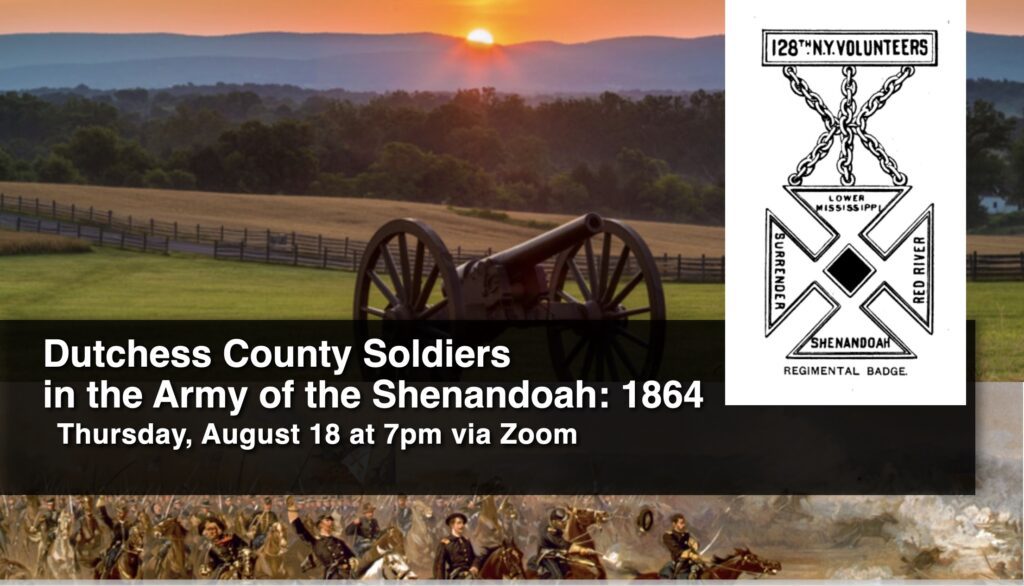Join Professor Michael Boden of Dutchess Community College for a riveting story on the exploits of the 128th New York Infantry during the 1864 Shenandoah Valley Campaign in Virginia. While the 150th New York was known as “The Dutchess County Regiment,” many other units recruited in Dutchess County during the war. The 128th was one of these, and arguably held the largest number of Dutchess County men outside of the 150th. While the soldiers of the 150th Regiment were fighting their way through Georgia, the men of the 128th were helping to close the noose around Robert E. Lee’s Army of Northern Virginia. Learn what brought Dutchess County soldiers to the Shenandoah Valley in 1864 and uncover a frequently overlooked element of Dutchess County’s role in the Civil War.

Dutchess County Participation in Civil War to be Subject of August 18 Talk
At Reservoir Square in Poughkeepsie (where South Clinton and Cannon Street meet), stands a monument that pays tribute to the men who fought in the 128th New York during the Civil War. The monument is imposing and distinctive to the landscape of the city, and commemorates the battles that were fought by that unit during the war, specifically in Louisiana 1863 and 1864 and the Shenandoah Valley in 1864. Of the four sides of the monument itself, one side is dedicated each to six battles in those regions.
In the case of the Shenandoah Valley, the monument raises some very interesting questions for consideration. The two months of campaigning in the Valley, from August to October, 1864, produced some of the most politically significant actions of the war during that year, particularly the Battle of Cedar Creek, the Federal victory taken from the jaws of defeat on 18 October, 1864. The 128th played a prominent role in that battle, and Cedar Creek is the final battle listed on its monument.
But the 128th was not the only Regiment with ties to Dutchess County that fought in that campaign. In fact, there were four regiments that fought in the Valley with Dutchess County connections, with three very different histories prior to Summer 1864. The 128th is understandably commonly perceived as the primary Dutchess County regiment in the Valley, with 6 of its 10 companies recruited in Dutchess County communities. But another regiment, the 159th New York, was established at the same time in 1862, served in the same Federal XIX Corps for the vast majority of the war, and fought alongside the 128th on many battlefields. The 159th, though, is far less well-known.
Part of the challenge is that, despite its unofficial nickname as the “Second Columbia and Dutchess Regiment,” the majority of soldiers in this unit were from Brooklyn; five companies were from the Hudson Valley counties while five hailed from the city. It is also interesting that there is no record of a “First” Columbia and Dutchess Regiment; the 128th’s nickname, infrequently cited or used, was “Old Steady.” But the 159th fought alongside the 128th in all of the major battles and actions in the Shenandoah, suffering comparable casualties and fortunes.
Additionally, two other units with ties to Poughkeepsie fought in the Shenandoah. The 6th New York Cavalry fought throughout the war in the Eastern Theater, and was heavily involved in most major campaigns. The regiment as a whole was recruited from throughout the states, but two troops were from Dutchess County: F Troop from Poughkeepsie and H Troop from Dover. In the Shenandoah, this Regiment, along with the Federal Cavalry as a whole, performed quite well, and the 6th played a prominent role in the victory at Tom’s Brook, and also, at the Third Battle of Winchester, participated in the largest cavalry charge of the Civil War.
The final Federal Regiment with Dutchess ties was the 5th New York Heavy Artillery. Heavy Artillery Regiments were organized as static defensive units, with troop manning authorizations normally twice that of a regular Infantry Regiment. At the start of the 1864 campaigning season, as Federal manpower issues were beginning to strain Northern resources, many of these “Heavies” were converted to infantry and sent to armies in the field, primarily in the East. The 5th New York Heavy Artillery was no exception, and after spending the majority of the first two years of the war alternating between assignments in Harper’s Ferry, West Virginia, and Washington, D.C., it was assigned to the Army of West Virginia, later known as the Federal VIII Corps, operating in the Valley.
At Cedar Creek, only four of the twelve companies in the Regiment were present on the battlefield, but two of those, F and K Companies, were comprised of men from Dutchess County. Also, by a curious twist of fate, on the morning of the battle, despite being in different Army Corps, the 5th was aligned alongside the 128th in the early fighting. Unfortunately for both of these units, the morning’s combat did not go well; the vast majority of the 5th were taken prisoner by the initial Confederate attack.
All of these diverse experiences raise a number of questions for those interested in Dutchess County’s experience in the Civil War. On Thursday, 18 August, at 7:00 p.m., the Dutchess County Historical Society will host a presentation on Zoom by Dr. Michael Boden, Associate Professor of History at Dutchess Community College, that examines the experiences of each of these units throughout the Shenandoah Campaign, and seeks to shed some light on the experiences of the men who fought there.
